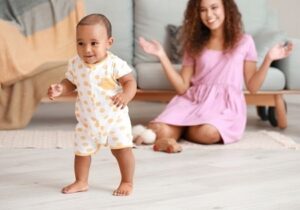 When walking begins, everything changes! From rolling and crawling to running and dancing, these milestones are the times parents look forward to. It’s only a matter of time before your baby starts showing the first sign of being able to walk before they tackle the big open world.
When walking begins, everything changes! From rolling and crawling to running and dancing, these milestones are the times parents look forward to. It’s only a matter of time before your baby starts showing the first sign of being able to walk before they tackle the big open world.
Your baby’s first steps might occur anytime after she learns to stand, but they will most likely happen in the first few days or months. They just need to start practicing to start trotting along.
So are you all set to chase your cutie around? Probably not. Let us help you understand more about what this means and how your baby gets to this important milestone.
Table of Contents
When do Babies Start Walking?
The typical age of independent walking in the United States is around twelve months. Similar timings have been recorded in numerous other countries, including Argentina, Ghana, India, Norway, Oman, South Africa, and Turkey. At around 12-13 months old, infants in these countries typically take their initial unassisted steps.
However, there are countries where most infants began walking many months before or later. And even within a single society, variation in terms of development may be significant. For example, a pair of infants in Switzerland started strolling alone at 8.5 months in a study tracking the growth of 220 children.
Some babies didn’t walk until they were nearly 20 months old. However, all those youngsters had excellent and normal motor development and cognitive capacity outcomes. The timing of independent movement was unimportant regarding the children’s later motor development and cognitive ability.
Of course, this isn’t always the case. In some situations, strolling delays are caused by medical issues or developmental disorders. However, the majority of late pedestrians do not have these difficulties.
Different Stages of Learning How to Walk
As you can see, learning to walk is a process that varies from person to person. Each newborn is different in its approach. Here’s a look at the typical stages your baby might go through on their way to genuine walking
- Crawling: Crawling begins at 7 to 10 months, according to the American Academy of Pediatrics (AAP). Some infants begin crawling by moving their hands and knees back and forth.
- Creeping: A youngster that creeps might pull herself ahead with her arms, which are stronger than the leg muscles at this time, and drag the rest of her behind.
- Scooting: Some youngsters crawl or creep, but some slide on their bottoms by pushing off with their arms. Alternatively, your toddler may slink commando-style on her stubborn belly.
- Cruising: The final stage of understanding before walking is usually cruising, which means your baby is standing upright while taking steps and holding on to a chair (or your leg or hand).
Signs That Your Baby is Ready to Walk
Babies must have the strength and coordination to maintain an upright posture on their own before they can walk. They also need to be able to support at least part of their weight—at a minimum for the time being. As children reach these motor signs, they are moving closer to independent strolling:
Sign 1: Pulling oneself up right into a standing position by gripping or holding onto someone or something
This ability develops within the first four months before infants take their own actions. An infant can stand for a few seconds at first, and you’ll notice that their legs are stiff and straight (as they stay in this picture). However, as the infant gets older, they will have the capacity to stand without support with knees slightly bent while holding on.
Sign 2: Walking with support
At this age, infants can shift their weight from one leg to another. If you grab a child by the hand, they can walk ahead. An infant may “cruise” or travel along sideways if she gets a grip on any item (like a couch or sofa).
According to research, children who walk alone tend to develop it about three months later. However, there is no organized sequence that all kids follow. Some youngsters begin walking with assistance prematurely even before they can creep. The following stage for these babies may be independent walking. However, crawling could also become a child’s primary interest as they mature.
Sign 3: Standing alone for a moment
How long does it take for a baby to walk unaided after learning? According To International Research, most babies start within 2-3 Months After Learning To Stand. However, it is not the total amount of time that matters most; it’s all about the quantity of practice and effort.
Infants begin to fall when they learn how to walk independently. Some children often don’t appear to mind much, and they immediately dive into the job and learn how to walk fast, frequently within a few days of learning to stand up independently.
How Babies Develop their Walking Skills
When children learn to walk on their own, they fall frequently. Many toddlers don’t appear to mind too much. They enter the task enthusiastically and discover how to walk fast—sometimes in as few as a couple of days of learning to stand up on their own.
How to Help your Baby to Walk
 There are great ways to encourage strolling; however, the best one is to allow your baby to have the possibility to check out her body and try it out for herself.
There are great ways to encourage strolling; however, the best one is to allow your baby to have the possibility to check out her body and try it out for herself.
Let your kid have lots of time beyond the infant stroller or service provider and also away from the playard or swing so she can see where her busy self takes her. Below are some specific ways to trigger those very first steps:
- Anticipate failures and quitters. If your youngster decides to exercise one more method to take a break from walking, their newfound mobility may last for a while. Your tiny crawler may enjoy zipping about the place when walking comes later on. After a bad fall or an illness, other new walkers might revert to crawling immediately.
- Incentivize walking. The same methods that entice a youngster to creep or bring up might inspire beginners. When she gets up to stand, place alluring toys at hand’s reach so she can attempt new ways of getting her prize.
- Hold their hand. You may also assist them in retaining balance by walking beside them while holding their hands.
- Trigger their “cruise” control. If your child can walk but is hesitant or unsure about what to do next, align sturdy furnishings to help them steady themselves as they go. If you haven’t already, make sure any coffee tables, TV stands, and other items your kid might use to maneuver himself are kid-proofed with no sharp edges or tripping hazards.
- Use a Push Toy. A tiny shopping cart, a claim, or a pint-sized lawn mower gives your youngster command as she holds and pounds it in front of her. It will also give her the help she requires while she uses those legs to fine-tune her equilibrium and boost her confidence. Look for toys with a bar or something she can lean on with big wheels that make it harder for the toy to fall over.
- Skip footwear for now. The ideal shoes for beginning walkers are nothing at all. Allow your infant to walk barefoot as far as feasible inside and outside certain surface regions to help develop muscular tissue tone in her feet and ankle joints, support her arches establishing, and discover balance and coordination.
- Offer comfy footwear outside. Keep your shoes light and flexible for outdoor excursions. Avoid clunky high boots or funky high-top tennis shoes; they’ll restrict your walker’s mobility.
- Limit time in activity centers. Although stationary centers do not bring with them the same degree of danger as walkers, they don’t help improve walking abilities, even if your kid can stand and play in one. Keep in mind that to walk, she must strengthen her torso and arm muscles—not just leg muscular tissues—so keep her out for no longer than 30 minutes at a time.
- Do not use a Baby Walker. A ban on the sale and manufacture of baby walkers in the United States has been suggested by the American Academy of Pediatrics (AAP), as well as studies indicating that they can stifle motor development, restrict average spinal form growth, and affect child posture. Worse, people may fall or roll down staircases, resulting in injuries.
The Threat with Baby Walkers
A baby walker is a rigid structure on wheels with a seat attached. A baby’s toes in the seat also hit the ground, allowing them to separate and push off in various directions when they grow bigger.
It may seem like a shortcut for discovering how to walk faster, but it isn’t. Rather, when babies use child walkers, they frequently assume strange postures and gait patterns. They might lean in reverse, creep along on tiptoes, or fall behind to control the motion of their head, among other things.
They aren’t practicing the steps they need to learn how to walk. The trend in the research literature is either neutral or unfavorable, and some research suggests that baby walkers provide no motor ability benefits.
Others have highlighted distinct disadvantages, including that babies who use baby walkers are typically slower to develop motor skills, such as crawling and standing alone, than those who do not.
However, safety is one of the most critical issues. Baby walkers are linked to an increased risk of injury. Babies dropping down staircases while walking on foot frequently cause mishaps. Some have wounded themselves by reaching for bulky, sharp, or burning-hot items. And the injuries can be severe; some babies have died.
When to Talk to a Healthcare Provider
 It’s crucial to remember that every youngster learns in different ways and at her own pace; therefore, if your infant isn’t walking by month ten or crawling by her first birthday, it’s not a cause for concern. You can’t speed up an infant’s development much, so keep offering secure and fun opportunities to practice walking during play.
It’s crucial to remember that every youngster learns in different ways and at her own pace; therefore, if your infant isn’t walking by month ten or crawling by her first birthday, it’s not a cause for concern. You can’t speed up an infant’s development much, so keep offering secure and fun opportunities to practice walking during play.
Even though this may seem to be a contradiction, there are some methods you’ll notice while your youngster is dancing around all of which are normal:
- Trips as well as falls. Yes, boo-boos do occur. Make sure your home is childproofed and that she’s been examined thoroughly at all times, not to mention avoid panic in her rolls and drops. Keep in mind that she has built-in bumpers. She’ll also likely forget about her trips and falls long before you do.
- Tiptoe walking. Some infants have a compelling desire to step on their toes, which may help them develop excellent balance. Tiptoeing rarely indicates too-tight calf or foot muscles, although it frequently disappears. Just check to see if your kid’s foot can physically flatten itself. If she cannot do so or still walks on her tippy-toes after two, bring it to the doctor’s attention.
- Bowed legs. She may have somewhat turned legs after nine months crumpled up in your womb. Bowed legs typically go away between 18 and 36 months, although they might linger for as long as three years old.
- Pigeon-toed feet. Another typical issue is “toeing-in,” or having a pigeon-toed gait as her shinbones have been bent. Thankfully, it typically corrects itself within six months of her initial step and does not require any outside assistance. If it persists longer, see your doctor.
- Flat feet. Look at those chubby legs and tiny flat feet; you’ll be amazed she can go everywhere. But, while her feet appear dull, they’re simply filling up with baby fat. It will “freeze” away by age 2 or 3, revealing her natural arches.
- Curvy feet. Some toddlers’ feet may also appear to be half-moons on the interior, similar to what happens with some infants. This is another child survival that has been handed down since birth and is taking its time to reverse.
- Toes pointing out. Some children toe out in their second year, but when they’re three or four, they begin to toe in. Even if the toeing-in does not look entirely correct, it’s unlikely to be a significant issue unless it impedes her walking and running. If it does, talk with your physician; corrective shoes can aid.
If you see your child repeatedly favoring one side, falling excessively, or exhibiting legs that appear too rigid, consult your pediatrician if she is showing any of the above symptoms.
Otherwise, enjoy her happy gait (that phone video clip will come in handy now) and commend her new exploits.
Final Thoughts When do Babies Walk
It is natural for a baby to learn how to walk differently, and there is no cause for concern if your baby does not follow the typical crawling and walking timeline. As long as you keep an eye on your child and ensure she is safe while practicing her new skills, enjoy watching her dance around!

